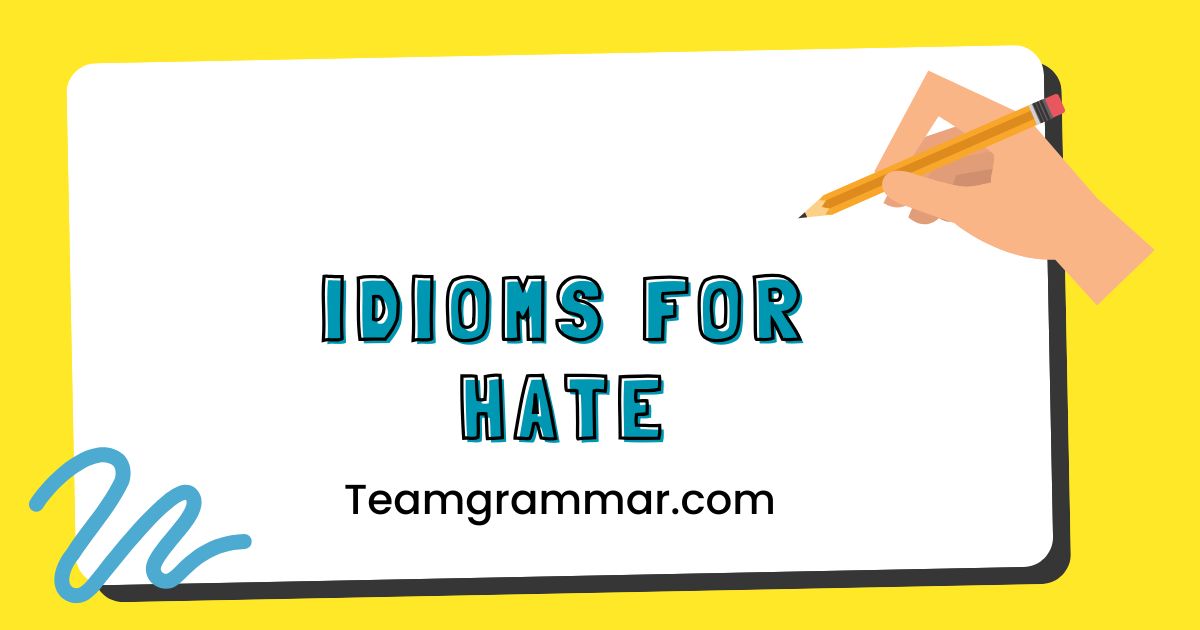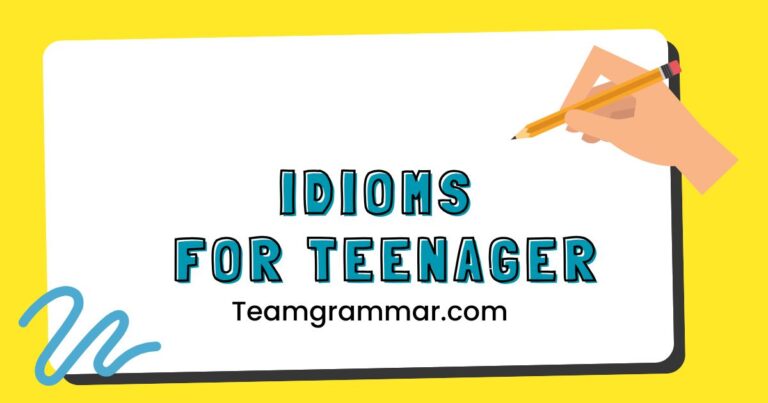35 Idioms for Hate: Expressing Dislike in English
Expressing dislike or hatred is a fundamental part of human communication. While simple words like “hate” or “dislike” are direct, idioms offer a more colorful and nuanced way to convey these feelings.
Understanding idioms related to hate is crucial for comprehending spoken and written English, as they frequently appear in literature, movies, and everyday conversations. This article will explore a variety of idioms that express dislike, aversion, and hatred, providing definitions, examples, and practical exercises to help you master their usage.
This guide is perfect for English language learners, avid readers, and anyone looking to enrich their vocabulary and improve their communication skills.
Table of Contents
- Introduction
- Definition of Idioms for Hate
- Structural Breakdown of Idioms
- Types and Categories of Idioms for Hate
- Examples of Idioms for Hate
- Usage Rules for Idioms of Hate
- Common Mistakes When Using Idioms for Hate
- Practice Exercises
- Advanced Topics: Nuances and Connotations
- Frequently Asked Questions
- Conclusion
Definition of Idioms for Hate
Idioms for hateare expressions that convey a feeling of strong dislike, aversion, or intense hatred in a figurative, rather than literal, way. An idiom is a phrase or expression whose meaning cannot be understood from the ordinary meanings of the words it contains.
These idioms often rely on cultural context and shared understanding. They add color, depth, and emotional impact to communication, allowing speakers to express their feelings more vividly than simple vocabulary might allow.
These idioms function as a form of figurative language, enriching our ability to articulate complex emotions. They are classified based on the intensity of the feeling they convey, ranging from mild dislike to extreme loathing.
Idioms related to hate often appear in both spoken and written English, including literature, movies, and everyday conversation. Understanding their meaning and proper usage is essential for effective communication and comprehension.
The context in which idioms are used is critical. The same idiom can sometimes carry different connotations depending on the situation and the speaker’s intent.
For example, an idiom used humorously among friends might be considered offensive in a formal setting. Therefore, it is incumbent upon the speaker to be aware of the social and cultural implications of the idioms they employ.
Structural Breakdown of Idioms
Idioms, including those expressing hate, typically consist of multiple words that, when combined, create a meaning distinct from the literal definitions of the individual words. The structure can vary, but common patterns include verb phrases, prepositional phrases, and similes.
It’s important to recognize that you usually cannot change the words in an idiom without altering or losing its meaning entirely.
Here’s a breakdown of common structural elements:
- Verb + Preposition: Many idioms use a verb followed by a preposition, such as “can’t stand” (to dislike strongly).
- Verb + Object: Some idioms involve a verb and an object, like “loathe the sight of” (to hate seeing someone or something).
- Similes: Idioms can also be structured as similes, using “like” or “as” to make a comparison, for example “hate something like poison.”
Understanding these structural patterns can help in identifying and interpreting idioms more effectively. However, rote memorization is often necessary since the meaning is not derived from the individual components.
It is also important to note that idioms are often fixed expressions. While slight variations might be acceptable in informal contexts, it’s generally best to use them as they are commonly known.
Altering the structure can lead to confusion or misinterpretation.
Types and Categories of Idioms for Hate
Idioms for hate can be categorized based on the intensity of the feeling they express. These categories help to distinguish between mild dislike, strong aversion, and intense hatred.
Recognizing these nuances is crucial for accurate and effective communication.
Idioms Expressing Strong Dislike
These idioms indicate a significant level of displeasure or aversion. While not as intense as hatred, they convey a strong negative feeling.
Examples include “can’t stand,” “find something distasteful,” and “take a dim view of.”
Idioms Expressing Aversion
Idioms in this category express a strong feeling of repugnance or disgust. They suggest an active desire to avoid something.
Examples include “wouldn’t touch something with a ten-foot pole,” “makes my skin crawl,” and “turns my stomach.”
Idioms Expressing Intense Hatred
These idioms convey the strongest level of negative emotion, indicating deep loathing or animosity. Examples include “loathe,” “detest,” “hate someone’s guts,” and “can’t bear.”
Idioms Expressing Mild Dislike
These idioms express a slight negative feeling, often indicating a lack of enthusiasm or preference. Examples include “not a fan of,” “not my cup of tea,” and “could do without.”
Examples of Idioms for Hate
The following sections provide detailed examples of idioms for hate, categorized by the intensity of the emotion they express. Each category includes a table with multiple examples to illustrate their usage.
Examples of Idioms Expressing Strong Dislike
These idioms are used to express a significant level of displeasure or aversion. They are stronger than mild dislike but less intense than outright hatred.
The table below provides several examples with contextual sentences.
| Idiom | Meaning | Example Sentence |
|---|---|---|
| Can’t stand | To strongly dislike something or someone. | I can’t stand the sound of nails scratching on a chalkboard. |
| Find something distasteful | To find something unpleasant or offensive. | I find his behavior towards the staff extremely distasteful. |
| Take a dim view of | To disapprove of something. | The teacher takes a dim view of students using their phones in class. |
| Have no patience for | To not tolerate something or someone. | I have no patience for people who complain constantly. |
| Not be able to stomach | To be unable to tolerate something. | I can’t stomach the thought of eating insects. |
| Rub someone the wrong way | To irritate or annoy someone. | His arrogant attitude always rubs me the wrong way. |
| Get on someone’s nerves | To annoy or irritate someone. | The constant noise from the construction site is really getting on my nerves. |
| Not a big fan of | To not particularly like something. | I’m not a big fan of horror movies. |
| Have a dislike for | To have a feeling of aversion towards something. | I have a dislike for overly sweet desserts. |
| Object to | To express disapproval or opposition to something. | I object to the proposed changes to the company policy. |
| Not care for | To not like something. | I don’t care for reality TV shows. |
| Disapprove of | To have an unfavorable opinion of something. | My parents disapprove of my decision to become an artist. |
| Be down on | To have a negative attitude towards something. | He’s always down on new technology. |
| Find something off-putting | To find something unpleasant or discouraging. | I find his aggressive sales tactics off-putting. |
| Not be keen on | To not be enthusiastic about something. | I’m not keen on going to the party tonight. |
| Have a problem with | To dislike or disapprove of something. | I have a problem with people who are always late. |
| Not think much of | To have a low opinion of something. | I don’t think much of his latest book. |
| Take exception to | To object strongly to something. | I take exception to being called a liar. |
| Be no friend of | To dislike or oppose something. | I’m no friend of excessive government regulation. |
| Look down one’s nose at | To regard someone or something with disdain. | She tends to look down her nose at people who haven’t gone to college. |
| Not be able to abide | To be unable to tolerate something. | I can’t abide people who cheat. |
| Have a strong aversion to | To have a strong dislike of something. | I have a strong aversion to public speaking. |
| Feel antipathy towards | To feel a strong dislike for someone or something. | I feel antipathy towards people who are cruel to animals. |
This table presents a variety of idioms that express a strong dislike, offering a range of options to convey your feelings effectively.
Examples of Idioms Expressing Aversion
These idioms indicate a strong feeling of repugnance or disgust, often leading to an active desire to avoid something. They are more intense than simple dislike and often imply a physical or emotional reaction.
| Idiom | Meaning | Example Sentence |
|---|---|---|
| Wouldn’t touch something with a ten-foot pole | To strongly avoid something. | I wouldn’t touch that project with a ten-foot pole after the last disaster. |
| Makes my skin crawl | To cause a feeling of disgust or revulsion. | The thought of spiders makes my skin crawl. |
| Turns my stomach | To cause nausea or disgust. | The smell of rotten food turns my stomach. |
| Can’t stomach | To be unable to tolerate something. | I can’t stomach the way he treats his employees. |
| Makes one’s blood run cold | To cause a feeling of fear or horror. | The eerie silence in the house made my blood run cold. |
| Give someone the creeps | To cause a feeling of unease or discomfort. | That abandoned house always gives me the creeps. |
| Couldn’t bear | To be unable to tolerate something. | I couldn’t bear the thought of living in a big city. |
| Loathe the sight of | To hate seeing someone or something. | I loathe the sight of litter on the streets. |
| Abhor | To regard with disgust and hatred. | I abhor violence of any kind. |
| Have a visceral reaction to | To have a strong, instinctive reaction to something. | I have a visceral reaction to the sound of fingernails on a chalkboard. |
| Hate something like poison | To hate something intensely. | I hate bureaucracy like poison. |
| Be allergic to | To have a strong aversion to something (often used humorously). | I’m allergic to early mornings. |
| Can’t abide | To dislike intensely; cannot tolerate. | I can’t abide arrogance. |
| Detest | To dislike intensely. | I detest having to wait in long lines. |
| Shrink from | To recoil from something in fear or disgust. | I shrink from the thought of returning to that place. |
| Find repulsive | To find something extremely unpleasant or disgusting. | I find his behavior repulsive. |
| Have a strong distaste for | To have a strong dislike for something. | I have a strong distaste for gossip. |
| Revolt against | To feel strong aversion to something; to rebel. | I revolt against the idea of conformity. |
| Feel revulsion towards | To feel intense disgust. | I feel revulsion towards cruelty to animals. |
| Be repulsed by | To feel intense disgust. | I’m repulsed by the sight of blood. |
This table offers a range of idioms that express aversion, allowing you to convey feelings of repugnance and the desire to avoid certain things.
Examples of Idioms Expressing Intense Hatred
These idioms convey the strongest level of negative emotion, indicating deep loathing or animosity. They are used to express profound dislike and often suggest a desire for harm or destruction.
| Idiom | Meaning | Example Sentence |
|---|---|---|
| Hate someone’s guts | To intensely dislike someone. | I hate his guts after he betrayed my trust. |
| Loathe | To feel intense dislike or disgust for something. | I loathe the feeling of being trapped. |
| Detest | To hate intensely. | I detest liars and cheaters. |
| Can’t bear | To be unable to tolerate something. | I can’t bear the thought of him winning. |
| Want to tear someone limb from limb | To be extremely angry with someone and want to hurt them. | When I found out he lied, I wanted to tear him limb from limb. |
| Wish someone were dead | To have a strong feeling of hatred towards someone. | After what he did, I wished he were dead. |
| Despise | To regard with contempt or disgust. | I despise people who take advantage of others. |
| Abominate | To detest or loathe. | I abominate violence and oppression. |
| Bear a grudge | To hold a persistent feeling of resentment or ill will. | He’s been bearing a grudge against me ever since our argument. |
| Have it in for someone | To be determined to cause trouble for someone. | The boss seems to have it in for me; he’s always criticizing my work. |
| Be out for blood | To be seeking revenge. | After the scandal, the media was out for blood. |
| Harbor animosity towards | To hold feelings of strong dislike or hostility. | She harbors animosity towards her former business partner. |
| Deep-seated hatred | A profound and ingrained feeling of hatred. | There was a deep-seated hatred between the two families. |
| Have no love for | To dislike intensely. | I have no love for politicians who break their promises. |
| Regard with contempt | To consider someone or something worthless. | I regard his actions with contempt. |
| Feel nothing but contempt for | To have a complete lack of respect for someone or something. | I feel nothing but contempt for people who are cruel to animals. |
| Be consumed by hatred | To be completely overwhelmed by feelings of hatred. | He was consumed by hatred after his family was wronged. |
| Want someone to drop off the face of the earth | To wish someone would disappear. | After what he did, I wanted him to drop off the face of the earth. |
| Wish something on someone | To hope something bad happens to someone. | I wouldn’t wish that kind of pain on anyone, not even my worst enemy. |
This table provides idioms that express intense hatred, allowing you to convey profound dislike and animosity.
Examples of Idioms Expressing Mild Dislike
These idioms express a slight negative feeling, often indicating a lack of enthusiasm or preference. They are used to convey a mild level of displeasure without strong emotion.
| Idiom | Meaning | Example Sentence |
|---|---|---|
| Not a fan of | To not particularly like something. | I’m not a fan of spicy food. |
| Not my cup of tea | To not be to one’s taste or preference. | Opera is not my cup of tea. |
| Could do without | To not need or want something. | I could do without the traffic on my commute. |
| Not be crazy about | To not be very enthusiastic about something. | I’m not crazy about going to that party. |
| Take no pleasure in | To not enjoy something. | I take no pleasure in having to reprimand you. |
| Not be wild about | To not be very enthusiastic about something. | I’m not wild about his new haircut. |
| Find something underwhelming | To find something disappointing or not impressive. | I found the movie underwhelming. |
| Have no great love for | To not like something very much. | I have no great love for early mornings. |
| Feel lukewarm about | To feel indifferent or unenthusiastic about something. | I feel lukewarm about the proposed changes. |
| Not be particularly fond of | To not be very fond of something. | I’m not particularly fond of long meetings. |
| Don’t have a taste for | To not enjoy or prefer something. | I don’t have a taste for modern art. |
| Not be one’s thing | To not be something that one enjoys or is interested in. | Camping is just not my thing. |
| Not float one’s boat | To not appeal to someone. | That kind of music doesn’t really float my boat. |
| Not be keen on | To not be enthusiastic about something. | I’m not keen on going to the gym today. |
| Not care much for | To not like something very much. | I don’t care much for reality TV. |
| Not think much of | To have a low opinion of something. | I don’t think much of his latest project. |
| Find something unappealing | To find something unattractive or unpleasant. | I find the idea of working overtime unappealing. |
| Not be drawn to | To not be attracted to or interested in something. | I’m not drawn to loud and crowded places. |
| Not have a preference for | To not prefer something. | I don’t have a preference for any particular brand. |
| Could live without | To not need something. | I could live without the constant interruptions. |
This table provides idioms that express mild dislike, allowing you to convey a slight negative feeling or lack of enthusiasm.
Usage Rules for Idioms of Hate
Using idioms correctly requires understanding their specific meanings and contexts. Here are some important rules to keep in mind:
- Context is Key: Idioms are highly context-dependent. Consider the social situation, your audience, and the overall tone of your communication.
- Figurative Meaning: Remember that idioms have a figurative, not literal, meaning. Do not interpret the words individually.
- Fixed Expressions: Idioms are generally fixed expressions. Avoid changing the words or structure, as this can alter or lose the meaning.
- Cultural Awareness: Be aware that some idioms may be culturally specific and not universally understood.
- Formality: Some idioms are more informal than others. Use formal idioms in professional settings and informal idioms in casual conversations.
Understanding these rules will help you use idioms effectively and avoid miscommunication.
Common Mistakes When Using Idioms for Hate
Here are some common mistakes to avoid when using idioms for hate:
| Incorrect | Correct | Explanation |
|---|---|---|
| I can’t stand of that. | I can’t stand that. | The preposition “of” is unnecessary and incorrect. |
| It makes my skin to crawl. | It makes my skin crawl. | The infinitive marker “to” is incorrect in this idiom. |
| I hate his stomachs. | I hate his guts. | The correct idiom is “hate someone’s guts,” not “stomachs.” |
| Opera is not my glass of tea. | Opera is not my cup of tea. | The idiom is “cup of tea,” not “glass of tea.” |
| I could do with of that noise. | I could do without that noise. | The correct idiom is “could do without,” not “with of.” |
Avoiding these common mistakes will help you use idioms more accurately and confidently.
Practice Exercises
Test your understanding of idioms for hate with these exercises.
Exercise 1: Fill in the Blanks
Choose the correct idiom from the list to complete each sentence: can’t stand, makes my skin crawl, hate his guts, not my cup of tea, could do without.
| Question | Answer |
|---|---|
| 1. I __________ people who are always late. | can’t stand |
| 2. The thought of public speaking __________. | makes my skin crawl |
| 3. After what he did, I __________. | hate his guts |
| 4. Horror movies are __________. | not my cup of tea |
| 5. I __________ the constant interruptions. | could do without |
| 6. She __________ the way he treated her. | couldn’t stand |
| 7. The sight of blood __________. | makes my skin crawl |
| 8. I __________ people who cheat. | hate their guts |
| 9. Football is __________. | not my cup of tea |
| 10. We __________ the negativity at work. | could do without |
Exercise 2: Matching
Match the idiom with its meaning.
| Idiom | Meaning | Answer |
|---|---|---|
| 1. Wouldn’t touch it with a ten-foot pole | a. To dislike intensely | 1. b |
| 2. Loathe | b. To strongly avoid something | 2. a |
| 3. Not a fan of | c. To not particularly like something | 3. c |
| 4. Turns my stomach | d. To cause nausea or disgust | 4. d |
| 5. Get on my nerves | e. To irritate or annoy someone | 5. e |
Exercise 3: Sentence Completion
Complete the sentences using the correct form of the idiom provided.
- I (can’t stand) ________ the sound of loud music. (Answer: can’t stand)
- He (take a dim view of) ________ people who are dishonest. (Answer: takes a dim view of)
- She (not be able to stomach) ________ the thought of eating meat. (Answer: is not able to stomach)
- The smell (make my skin crawl) ________. (Answer: makes my skin crawl)
- I (loathe) ________ having to work on weekends. (Answer: loathe)
Advanced Topics: Nuances and Connotations
For advanced learners, it’s essential to understand the nuances and connotations of idioms for hate. Some idioms are more formal or informal than others, and some carry stronger emotional weight.
For instance, “loathe” and “detest” are more formal and intense than “can’t stand.”
Additionally, cultural context plays a crucial role. An idiom that is acceptable in one culture may be offensive in another.
Therefore, it’s important to be sensitive to cultural differences and use idioms appropriately.
Finally, pay attention to the subtle differences between seemingly similar idioms. For example, “makes my skin crawl” and “gives me the creeps” both express aversion, but the former implies a more physical reaction, while the latter suggests a feeling of unease or discomfort.
Frequently Asked Questions
- What is an idiom?
An idiom is a phrase or expression whose meaning cannot be understood from the ordinary meanings of the words it contains. It’s a figurative expression that has a meaning different from the literal meaning of its individual words.
- Why is it important to learn idioms?
Learning idioms is important for understanding spoken and written English, as they frequently appear in literature, movies, and everyday conversations. It also enriches your vocabulary and improves your communication skills.
- How can I learn idioms effectively?
You can learn idioms effectively by reading widely, listening to native speakers, and practicing using them in context. Flashcards and idiom dictionaries can also be helpful.
- Are idioms universal?
No, idioms are not universal. Many idioms are culturally specific and may not be understood in other cultures. It’s important to be aware of cultural differences when using idioms.
- Can I change the words in an idiom?
Generally, no. Idioms are fixed expressions, and changing the words can alter or lose the meaning. It’s best to use them as they are commonly known.
- What is the difference between an idiom and a metaphor?
A metaphor is a figure of speech that directly compares two unlike things without using “like” or “as.” An idiom is a phrase whose meaning is different from the literal meaning of its individual words. While some idioms may be metaphorical, not all idioms are metaphors.
- How do I know when to use an idiom?
Use idioms when you want to add color, depth, and emotional impact to your communication. Consider the social situation, your audience, and the overall tone of your message. Avoid using idioms in formal or technical contexts where clarity is paramount.
- What should I do if I don’t understand an idiom?
If you don’t understand an idiom, try to find its meaning in an idiom dictionary or ask a native speaker for clarification. Pay attention to the context in which the idiom is used, as this can often provide clues to its meaning.
- Are there any idioms that express both hate and love?
While there aren’t idioms that directly express both hate and love simultaneously, some idioms can express a complex mixture of emotions, such as “love-hate relationship,” which suggests a relationship characterized by both strong affection and strong dislike.
- How do I avoid misusing idioms?
To avoid misusing idioms, make sure you understand their specific meanings and contexts. Practice using them in sentences and get feedback from native speakers. Be aware of common mistakes and avoid changing the words or structure of the idiom.
Conclusion
Mastering idioms that express hate is a valuable skill for English language learners and anyone seeking to enhance their communication abilities. By understanding the nuances of these expressions, you can convey your feelings more vividly and accurately.
Remember to consider the context, audience, and cultural implications when using idioms. Consistent practice and exposure to the language will help you internalize these expressions and use them confidently.
Continue to expand your vocabulary and explore the rich tapestry of the English language. Pay attention to how native speakers use idioms in different situations, and don’t be afraid to experiment with new expressions.
With dedication and practice, you can become proficient in using idioms for hate and other emotions, adding depth and color to your communication.







